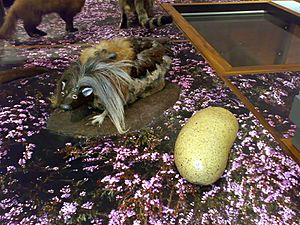Wild haggis facts for kids

The wild haggis (Haggis scoticus) is a fictional creature. It is said to live in the Scottish Highlands. People jokingly say it is the source of the traditional Scottish dish called haggis. This creature is part of Scottish folklore and humor.
Contents
What is a Wild Haggis?
The wild haggis is not a real animal. It is a funny story or a prank often told to tourists visiting Scotland. People describe it as a small, furry creature. It is said to have legs of different lengths. This helps it run around the steep Scottish hillsides.
The Mythical Creature
People often imagine the wild haggis as looking a bit like a small, shaggy sheep or a large rodent. Its legs are a key part of the joke. They are said to be shorter on one side of its body. This allows it to run quickly around the hills without falling over. If it turns around, it would tumble down the hill!
Its Fictional Habitat
The wild haggis is said to live in the rugged Scottish Highlands. This area is known for its tall mountains and deep valleys. The idea of a creature with uneven legs makes sense in such a hilly place. It adds to the humor of the myth.
Imagined Habits and Appearance
According to the joke, there are two types of wild haggis. One has shorter left legs, and the other has shorter right legs. This means they can only run around the hills in one direction. If they try to turn around, they would lose their balance. This funny detail makes the story even more entertaining.
The Real Haggis Food
The wild haggis is linked to the famous Scottish dish, haggis. Real haggis is a savory pudding. It is made from sheep's pluck (heart, liver, and lungs). These are minced with onion, oatmeal, suet, spices, and salt. The mixture is traditionally cooked inside a sheep's stomach. Today, it is often cooked in an artificial casing. It is a very important part of Scottish culture. It is especially popular on Burns Night, which celebrates the poet Robert Burns.
Is the Wild Haggis Real?
No, the wild haggis is not a real animal. It is a long-standing joke. It is often used to playfully trick visitors to Scotland. Many Scots enjoy telling the story. They watch for the reaction of people who have never heard it before. It is a fun part of Scottish humor and tradition. The myth shows the playful side of Scottish culture. It also highlights the unique landscape of the Highlands.
See also
 In Spanish: Haggis salvaje para niños
In Spanish: Haggis salvaje para niños

